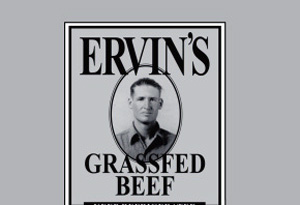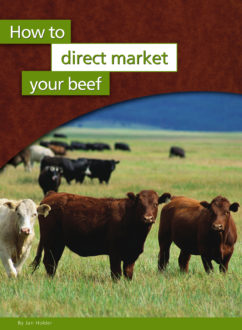
If you plan on having your product cross state lines, you have to have a federal label. A federal label can only come from a federally inspected plant. Your label is attached to your processing plant. For instance, we have a separate label for our jerky and marinated roasts than for our other beef products. They look almost the same. The only difference is the establishment number in the circle in the lower-right corner. That’s it. The plant that does your processing will apply to the federal government for your label. You need to have the artwork created – preferably on a computer, so that changes can be made easily – then give it to your processing house to have it approved. Some plants will provide this service for you, usually at no charge.
Obtaining approval on your label can take as little as 10 days, or many months, depending on how out of the ordinary your label is and the experience of the processing company.
When we applied for our first federal label, it took quite a while. Our processing house had never applied for a label with anything strange like natural on it. Even adding that fairly innocuous word apparently makes the feds nervous. Our label kept being rejected over and over, and we couldn’t figure out why.
Finally, out of desperation, we hired a label expediter to help get our label through. An expediter is a person who knows all the guys in Washington who fret over the terms like natural and organic and hormone-free. He gets paid a lot of money for knowing where their offices are and what questions to ask when they tell him that your label was rejected. And, most amazing, he can tell you exactly what to change so that the label will pass. After months and months of going around and around with our label, it turned out that what was wrong was frustratingly simple. We stated on the label – “Keep Refrigerated or Frozen.” It turns out that we can say, “Keep Refrigerated” or “Keep Frozen,” but not both. How could we have been so misinformed? Actually, in the end it was not really very expensive (a couple hundred dollars), and we should have hired the expediter a lot sooner.
While I would never claim to entirely understand the label approval office, they seem to be getting more user-friendly. You can find out more about labels and getting your approval at www.fsis.USDA.gov/home. If you want to sell your product as certified organic, your label as well as your processing plant also will have to be approved by your state or third party certifier.
The easy thing to do is to team up with a processing house with experience dealing with natural or organic labels or copy one that has already been approved. Don’t try to do your advertising with your product label. You will never win in a battle with federal regulators. Make all your claims on your point-of-purchase material or your product literature, not on your federal label. Anything that you say on your federal label has to be approved by the feds. That is time-consuming, at best.
If you want to say that your beef is better for you, say it in your brochures. If you want to say that your beef is tender, say it in your brochures. If you put it in your brochures, it’s just your business. If it’s on your federal label, it’s the feds’ business.
LABEL SOURCES
When you’re first starting out, especially when you are still deciding what your product mix will be, go to a small printing company for your labels. You want to order pressure-sensitive labels that come on continuous-feed rolls. Your quantities will be too small for a regular label company to be cost-effective. Most small printing companies sub-contract with a to-the-trade-only label printer.
Make all your labels the same color (although you can create screens of one color for more visual interest) and try to do them all at once. You may have different quantities of each – 1,000 stew beef labels, 500 sirloin steak labels, 500 tenderloin steak labels, and 3,000 ground beef labels. Go with a standard size, as custom sizes are a lot more expensive. Sizes usually run in 1-inch increments.
When your volume is higher (such as 10,000 labels or more), deal directly with a label printing company. Most major metropolitan areas have one or two. Look in the yellow pages. Get bids from two or three if possible. Make sure to give them the following information: quantity of each label, total quantity, size, ink color, color of stock (the paper that the labels are printed on), whether the labels need to be waterproof, and delivery location. Expect a four-week turnaround time.
